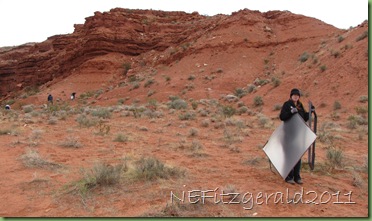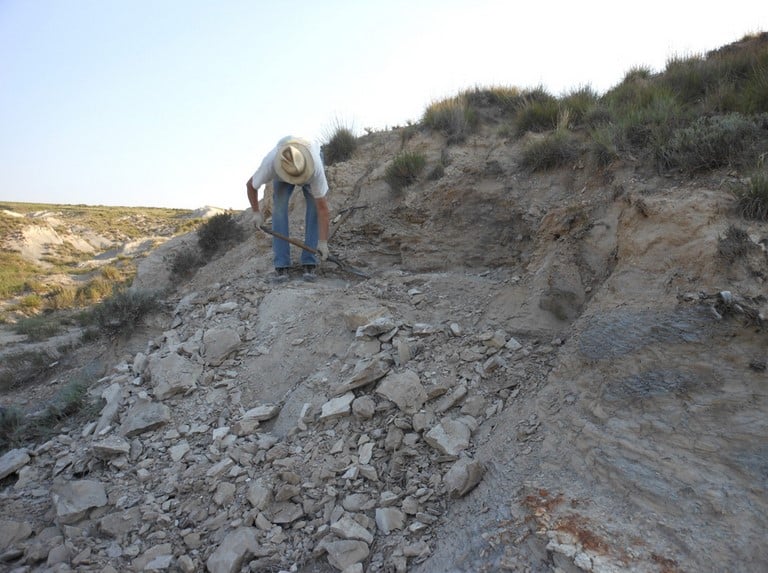This week I took a leisurely walk in the Red Cliffs Desert Reserve near my home in southwestern Utah and noticed scores of small animal tracks that had been imprinted that very morning. The next day I stood staring in amazement at a trace of small animal tracks in the red rock sandy siltstone that had been imprinted nearly 200 million years earlier.
I have been volunteering with the St. George Dinosaur Discovery Site at Johnson Farm (click here and here) for the past couple of winters. Usually I work in the lab on fossil fish, viewing the sample through a microscope and picking away the sandy silty matrix with a carbide–tipped hand tool.
But last week the oldest known Lower Jurassic Moenave fossil locality in Washington County needed our attention. Andrew Milner, dinosaur site paleontologist, put out a call for help. He would be leading a field trip to the site this weekend with the Society for Vertebrate Paleontology. Sadly, a significant amount of garbage had been dumped into the canyon over the past year, and he hoped the area could look clean and spiffy. So on a chilly, windy late–October morning the gaggle of usual suspects gathered with buckets and gloves and pick–up trucks, ready to haul out as much trash as we could manage.
 |
| Volunteers clean up the canyon |
 |
| Melinda carries it out |
 |
| Linda ready to move some trash |
 |
| Loading up the trash |
 |
| Thanks, Volunteers! |
Trackways have been and continue to be discovered all over Washington County. The small four–toed footprint is believed to be Batrachopus, made by an early crocodile relative such as Protosuchus. As you can see from the photo, these footprints are tiny! Unless you know what you are looking for, they are easily overlooked. In addition, these croc–like critters walked on all fours and their back foot often stepped where their front foot had been, “overprinting” the front print and obscuring it. These (even) smaller front prints can be found but are not as common as the back print.
 |
| Batrachopus – gloved finger for scale |
The larger prints are Grallator, made by a small meat–eating dinosaur and much easier to distinguish in the surrounding rock.
 |
| Grallator – booted feet for scale |
Anhydrites and other evaporites from the underlying Chinle Formation up through Dinosaur Canyon member of the lower Moenave indicate that dry, arid conditions prevailed. But as time went on the environment became wetter and less arid. The early environment where these animals thrived was much different from the Utah of today. Geological evidence shows that it was a shallow, flat–lying meandering river system. Currents would have flowed from the southeast towards the northwest, from mountains in what is now Texas into a low–relief landscape of an ancient Utah, Idaho, and Wyoming.
Moving up–section through the Dinosaur Canyon member to the Whitmore Point member of the Moenave we see evidence of a large freshwater lake now known as Lake Dixie. It was along the edges of this vast inland body of water that our early meat–eating dinosaurs and crocodile relatives walked, leaving proof of their existence for us to discover in the red rock canyons of southern Utah.
 |
| Andrew points out Chinle/Moenave contact |
 |
| Peering up into the Moenave |
 |






